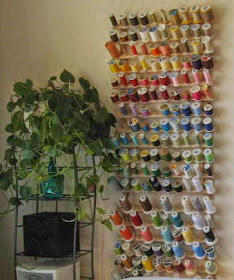If I had to choose what I like best about this block it would be the pink and green mini-quilt. It's a real quilt! Pieced and everything! I only cheated on the border. It's satin stitched. The little blocks are just 1/2" square, and I loved making it!
But on to the problems. Sigh...
It isn't that the block is hard to sew. Even though it has so many little bits and pieces of laundry, it goes together just like the others. Or, at least it should go together just like the others. Not for me, though. Not this time.
It all began when I ran out of stabilizer for my applique. I was in a bit of a hurry, so I grabbed something inexpensive from a nearby craft store. I thought it was similar to a more expensive stabilizer I'd used before, but when I opened the container, it was altogether different. Not in a good way, either! Word of warning - do not get the water soluble stabilizer that feels like a plastic bag! It sticks to the bed of the sewing machine and totally messes up the length of zigzag stitches!
I stopped everything and went out to the quilt shop to buy some good stuff. More expensive, but so worth it. This one is a tear-away and works beautifully.
Stabilizer, though, was only the first of my problems. Next came the thread issue. I have thread in every color imaginable.
Ha!
 |
| Only one portion of my thread collection. |
It wasn't till I had done all of this sewing with a very short triple stitch, that I realized how awful it looked!
What a mess!
An hour and a half later I had it all unstitched, but the jeans are looking a bit the worse for wear. I might have been better off drawing those lines with a permanent marker in the first place. I definitely would have been better off simply starting over!
Well, it's too late to do any of that now. The block is finished and it stays as it is! A small imperfect piece won't ever be noticed in such a busy quilt. Will it? Nope. Not going there at all. It's fine. So there!
Truth be told, my sigh of relief at having it finished was huge. The block is done, the pattern made, and aside from the mishaps and mixups it really was loads of fun.
This quilt is really coming along!! I may move blocks around, but it's not looking half bad! What shall we add? We only need one large block and one or two small ones, depending on the size of the larger one.
There is only one little niggling worry about the clothesline block.
That other yellow sock ...
the one not on the clothesline ...
It had better be in here somewhere!
Unless the washing machine ate it.












